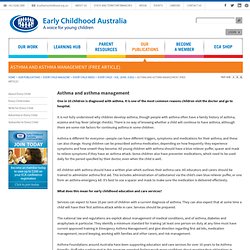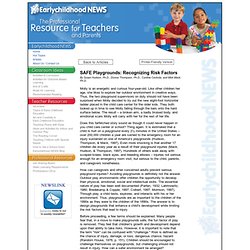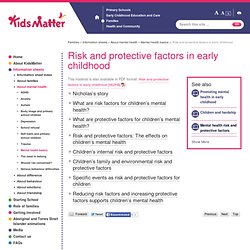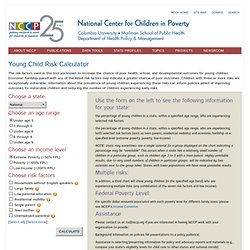

Asthma and asthma management (free article) One in 10 children is diagnosed with asthma.

It is one of the most common reasons children visit the doctor and go to hospital. It is not fully understood why children develop asthma, though people with asthma often have a family history of asthma, eczema and hay fever (allergic rhinitis). There is no way of knowing whether a child will continue to have asthma, although there are some risk factors for continuing asthma in some children.
Asthma is different for everyone—people can have different triggers, symptoms and medications for their asthma, and these can also change. Young children can be prescribed asthma medication, depending on how frequently they experience symptoms and how unwell they become. All children with asthma should have a written plan which outlines their asthma care.
Www.education.vic.gov.au/Documents/school/principals/spag/safety/protectionofchildren.pdf. Early Childhood. Earlychildhood NEWS - Article Reading Center. Molly is an energetic and curious four-year-old.

Like other children her age, she likes to explore her outdoor environment in creative ways. Thus, the two playground supervisors on duty should not have been surprised when Molly decided to try out the new eight-foot horizontal ladder placed in the child care center for the older kids. They both looked up in time to see Molly falling through the bars onto the hard surface below. The result – a broken arm, a badly bruised body, and emotional scars Molly will carry with her for the rest of her life.
How can caregivers and other concerned adults prevent serious playground injuries? Before proceeding, a few terms should be explained. Although playground safety can be a complex issue, the National Action Plan for the Prevention of Playground Injuries (Thompson & Hudson, 1996) has identified four major elements of playground risk that together account for nearly every playground injury or death. Separation of Equipment. Open Sight Lines. Risk and protective factors in early childhood. This material is also available in PDF format: Risk and protective factors in early childhood [962KB] pdf Nicholas’s story(content changes below) Recently, four-year-old Nicholas’s sister was born with an illness.

Nicholas’s parents were spending a lot of time at the hospital so he would stay at his aunty’s house. His parents were really tired when they came home from the hospital and didn’t feel like spending time together like they used to. Nicholas tried to make his parents feel better by drawing pictures, but it didn’t seem to help. What are risk factors for children’s mental health? Some children, for different reasons, are more at risk than others of developing mental health and behavioural difficulties. It is a combination of the negative effects of risk factors that lead to the development of children’s mental health difficulties. Every child and family will experience some difficulties, and each will have some resources and strengths to help through difficult times. Young Child Risk Calculator. The risk factors used in this tool are known to increase the chance of poor health, school, and developmental outcomes for young children.

Economic hardship paired with any of the listed risk factors may indicate a greater chance of poor outcomes. Children with three or more risks are exceptionally vulnerable. Information about the prevalence of young children experiencing these risks can inform policies aimed at improving outcomes for vulnerable children and reducing the number of children experiencing early risks. Use the form on the left to see the following information for your state: the percentage of young children in a state, within a specified age range, who are experiencing selected risk factorsthe percentage of young children in a state, within a specified age range, who are experiencing both selected risk factors (such as teen parent, residential mobility) and economic hardship at a specified level (extreme poverty, poverty, low-income) Multiple risks: Federal Poverty Level:
Development, risk burden and early childhood education - CFCA Connect - Child Family Community Australia (CFCA) Written by Robyn Seth-Purdie1 and Nicholas Biddle2 The science of early child development tells us how important it is to provide an environment that promotes healthy development during the first years of life.

This is a time when the foundations for lifelong health, learning, earning and positive social interactions are established. Exposure to intense, prolonged stress that is attributable to abuse or neglect in early childhood can have lasting physiological and behavioural consequences. Conditions that compromise development and make poor outcomes more likely can be labelled “risk factors”. The cumulative effect of exposure to risk factors is then a child’s “risk burden”. EffervescentEva/Flickr In research commissioned by Goodstart Early Learning and published by the Australian National University’s HC Coombs Policy Forum, we examined the relationship between risk burden, participation in ECE in the year before full-time school, and development outcomes two years later. 1. 2.